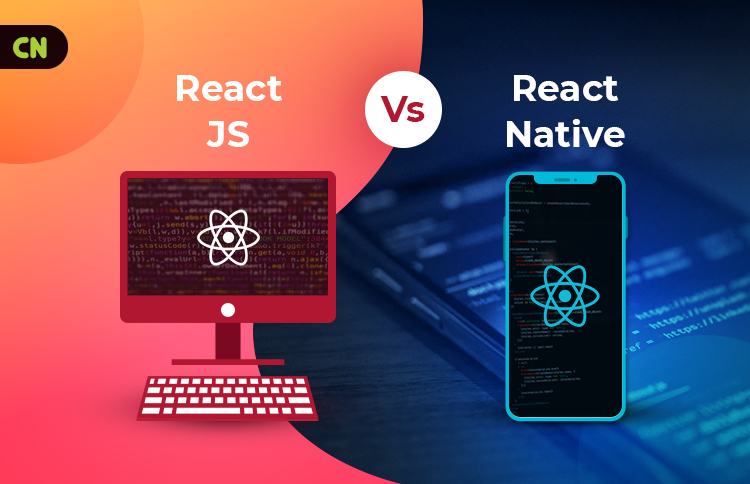ReactJS Vs React Native
Table of Contents
Sure, ReactJS and React Native share the same technology backbone, but, there are marked differences between the two.
ReactJS was launched by the Facebook team in 2011 for creating high-performing web apps.
Whereas, React Native was founded four years later to develop cross-platform mobile apps with native functionalities.
TL;DR
- Go for ReactJS, if you’re looking to build web apps.
- Choose React Native, if you’re interested in creating mobile apps.
Let’s delve into each to get a better grasp:
ReactJS
Developed by Facebook, React or ReactJS is an open-source JavaScript library that is created for developing gorgeous web interfaces.
Unlike other frameworks that use the traditional DOM, ReactJS uses virtual DOM. And how does it benefit? Well, the traditional DOM responds to each user query or change by updating the entire document or page, resulting in slower updates. However, React’s virtual DOM updates only parts of the page, instead of refreshing the entire web page. This results in quicker updates and decreases the page refresh time.
To list them down:
- ReactJS a JavaScript library that’s used to create UI hierarchy.
- It’s mainly used to develop single-page applications, websites, web apps, etc.
- It helps render UI components.
- React’s virtual DOM offers quicker updates by refreshing only parts of a page as against traditional DOM’s full-page refresh model, which is slower.
- Isolated components in ReactJS help designers reuse code without affecting the others, thereby, improving the design process.
React Native
Built by Facebook, React Native is a JavaScript mobile framework. This open-source framework lets developers use platform-agnostic native components (such as Text, Image, and View) to create native iOS and Android apps.
React Native facilitates super-fast app development, thanks to JavaScript. React components interact with native APIs via JavaScript to create native applications. It makes it possible (and even easier) for the developers to create cross-platform apps from a single codebase. As a result, the hassle of developing a code structure from scratch could be avoided. The result? Quicker app development.
Besides, over 1200 contributors in the React community regularly come up with innovative ideas and valuable inputs in the world of tech, making it easier for the developers to create dynamic mobile apps.
Thousands of organizations, ranging from renowned Fortune 500 companies to hot new startups, use React Native today. Since the time of its launch, React Native was used by influential firms like Instagram, Skype, Facebook, Tesla, Bloomberg, Airbnb, Walmart and Uber Eats. Clearly, the curiosity to work with this framework is constantly growing.
To list them down:
- React Native helps developers write natively rendering mobile apps for both Android and iOS.
- React Native saves around 40% to 90% of app development time.
- It has a highly supportive and motivated community that offers key insights and explores platforms like React Native Windows and React Native Web apart from iOS and Android.
Although the differences between ReactJS and React Native are a lot more than their similarities, however, some key elements are relevant to both. Let’s talk through the similarities first:
Key Similarities
- Both ReactJS and React Native use JavaScript libraries.
- Both are highly suitable for quick and complex UI building.
- Both use Redux to manage application state.
- Both follow the same React to component-based architecture.
However, what people talk about the most are the differences between the two that make each one unique in its own way. Here’s a small comparison below:
Primary Differences
| ReactJS | React Native | ReactJS is a Javascript library. | React Native is a framework. | ReactJS is used to develop user interfaces for large web apps. | React Native contains native libraries used to create mobile apps. | The browser code in ReactJS is rendered through virtual DOM. | React Native leverages the power of native APIs to build native mobile apps. | ReactJS uses React-Router for navigation. | React Native uses a third-party library for navigation. | Since ReactJS isn’t a framework, therefore, it requires third-party library tools for app development. | React Native does not require third-party tools for app development. | ReactJS helps animate various components of a web application or software using CSS. | React Native helps animate various components of an app through animated API. | ReactJS leverages web-page load speed, code reusability, and SEO-friendliness by combining technologies like HTML and JavaScript. | React Native framework comes with reusable native components that compile directly to native, thereby, helping hybrid mobile apps to have native functionalities. |
Currently, mobile apps are predicted to generate a total of $188.9 billion in global revenue through app stores and in-app advertising in 2020. (Statista).
These numbers may be hard to swallow, but they clearly explain why developers are heavily relying on React Native to write brilliant applications.
To Conclude
Whether you use ReactJS or React Native, both can help you build apps with faster speed and complex features. All you need is a team of talented programmers who can turn your vision into reality.
If you’re looking to build a React app from the ground up, reach out to us.
We’d love to discuss your business goals and help you keep in sync with this growing technological space.















